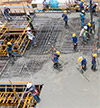Regulatory decisions further heighten the importance of ESG. A change that will soon make itself felt is the Securities and Exchange Commission (SEC) release of ESG disclosure rules for Scope 3 emissions. (The Environmental Protection Agency defines Scope 3 emissions as “the result of activities from assets not owned or controlled by the reporting organization, but that the organization indirectly impacts in its value chain.”) Combined, these factors mean one thing for developers and corporations undertaking capital projects: not only will they have to institute, track, and report their own ESG efforts, but they will have to include those of their contractors and other project partners.
What are the New Metrics?
Requiring all business partners to demonstrate responsible practices for environmental, social, and governance concerns is a broad request. To achieve success, the entire project team will have to break their processes down into manageable pieces, identifying metrics and outlining specific rules for meeting, measuring, and reporting those metrics. Fortunately, some contractors and other stakeholders are poised to meet them more than halfway.
Investors and lenders increasingly view a company’s ESG policies as indicative of how that company is positioning itself for success in the marketplace. Environmental/Sustainability — Sustainable building has been an important topic in the construction industry for years. Great strides have been made in identifying life-cycle costs/benefits and balancing competing considerations across the lifetime of a structure. Many contractors are now well-versed in the kind of early planning that makes these assessments and decisions possible. Thorough pre-construction planning and sourcing phases are the key, and these phases should prioritize:
- Sustainable site planning
- Safeguarding water and water efficiency
- Energy efficiency and renewable energy, with a focus on:
- Conducting a comprehensive energy analysis
- Enhancing a building’s environmental management system (EMS)
- Installing sensor systems to monitor and adjust environmental conditions
- Installing demand-based fresh air distribution
- Installing ventilation heat recovery systems
- Retrofitting indoor and outdoor lighting systems using LED or other technology
- Implementing solar solutions
- Pursuing LEED certification
- Conservation of materials and resources
- Indoor environmental quality
Great strides have been made in identifying life-cycle costs/benefits and balancing competing considerations across the lifetime of a structure. To comply with the principles of ESG, teams are also expected to enhance the quality of life of the people in surrounding communities. A direct way to accomplish this is to establish a funding program (or partner with contractors who have funding programs), supporting charitable 501(c)(3) nonprofit organizations that align with the team’s values. Often this means providing basic needs to area residents, such as food, shelter, education, and healthcare, as well as civic, environmental, and cultural programs. Along with financial assistance, volunteer involvement on the part of project stakeholders is also desirable.
Diversity, equity, and inclusion (DEI) is another pillar of social responsibility. Advancing DEI should begin with team culture and employee development, then extend to trade partners and communities. Because there are many factors for achieving success with DEI efforts, contractors and other partners should demonstrate that they have set up a company-wide council, with council members from across different departments. The goal should be to not only increase the participation of women and minorities, but also to make changes in operations and communications to sustain diversity. This means identifying and removing biases in recruiting, hiring, and promotion as well as educating people already within the organization to make them inclusive leaders and individual contributors.
Supplier diversity is another aspect of strengthening the social fabric. Working with and supporting minority-owned, women-owned, and small businesses contributes to the economic growth and expansion of communities. It is a good idea for owners and contractors to have established supplier diversity programs in place to support this goal.
The International Living Future Institute (ILFI), through their Just Program, encourages organizations to disclose employee-related indicators to measure social performance. The good news is that most organizations have progress on one or more of the institute’s indicators. Disclosing program results can demonstrate a firm’s formal commitment to social well-being.
Indicators include:
- Employee benefits
- Healthcare
- Retirement provision
- Family/medical leave
- Training and education
- Stewardship
- Local communities
- Volunteering
- Charitable giving
- Diversity, equity, and inclusion
- Gender/ethnic diversity
- Engagement
- Full-time employment
- Pay-scale equity
- Purchasing and supply chain
- Equitable purchasing
Responsible social behavior begins with how a company, organization, or team treats its own employees. Furthermore, all business development strategies and business practices should support the team’s core values, which, in turn, should emphasize honesty and integrity, commitment and follow-through, and full transparency (a “no-surprises” management style). Team interactions should be based on a thorough understanding of customer and project needs and on long-term continuity in client and subcontractor relationships. A commitment to innovation and investment in new technology, along with a system of subcontractor prequalification, further contributes to solid project outcomes.
To assure that all participants in a construction project are meeting the demands of ESG, the team should pursue mastery of logistics and coordination. Implementing ESG should involve inventorying current efforts, performing a GAP analysis, developing a system of metrics and tracking, and informing and educating internal stakeholders.
Taking all of its components together, ESG’s requirements for owners and their partners to not only protect the environment and reduce energy use, but make positive contributions to their communities, adopt inclusive policies, and maintain high standards of governance require a new level of planning from the top down. Once plans are in place, tracking and reporting — underpinned by transparent and comprehensive team-wide communications — is the recipe for success.




